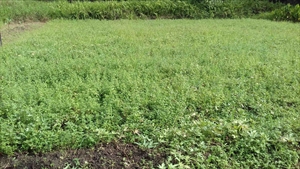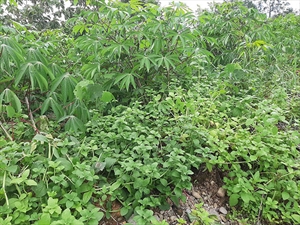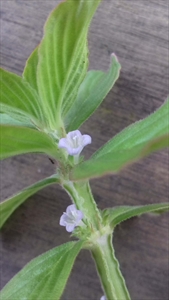Winged false buttonweed. It is also known as the broad-leafed buttonweed, broadleaf buttonweed. Note, this name is also given to Spermacocoe alata, e.g., by USDA Natural Resources Conservation Service.
Pacific Pests, Pathogens, Weeds & Pesticides - Online edition
Pacific Pests, Pathogens, Weeds & Pesticides
Winged false buttonweed (491)
Spermacoce latifolia; previously, it was known as Borreria latifolia. Note, The Royal Botanic Gardens Kew lists this species separately from Spermococe alata. According to RBG, Spermococe latifolia has spread widely from South and Central America, including to the Pacific, whereas Spermococe alata is a weed of South America alone. Some online websites suggest these two species are the same. It is a member of the Rubiaceae.
Asia, Africa, North (Mexico), South and Central America, the Caribbean, Europe (Spain), Oceania. It is recorded from Australia, Fiji, French Polynesia, and Samoa. It is a native of Mexico and Central America.
A perennial weed of tropical climates, rapidly growing and producing large amounts of seed within 2 months. Favours open forests, rain forests, agricultural land, riverbanks, roadsides, and other disturbed areas (Photos 1-3). CABI lists the broadleaf buttonweed (Borreria latifolia) as a common weed of sugarcane, rubber, oil palm, orchards, tea, and in upland maize, soybean, and rice. Prefers sandy soil. It occurs from near sea level to 800 m.
Stems mostly erect to 1 m (sometimes spreading), square in cross-section, narrowly 'winged', 0.2-0.5 mm, woody at basal nodes, sometimes rooting (Photo 4). Leaves, broad and hairy, oval, 2-4 x 1.8 cm, without leaf stalks or only to 1 cm (Photo 5); cup-shaped stipules at base with bristles on edges, 2-5 mm long. Flowers at the top of stems and in axils of leaves (Photos 4-6). Individual flowers surrounded by four small green leaves with hairy margins. Four, petals fused to form funnel-shaped tube, 5 mm long, white, pale blue or mauve, with oval to triangular-shaped lobes. Fruit about 2.5-3 mm long, covered in white hairs. Seeds about 3 x 1.8 mm, smooth with long cavity on one side (Photo 7). It has a long flowering time, and often flowers and fruits occur on the same branches.
Spread is by seed. Seed can contaminate livestock feed, grain, seed of other species. Spread to Spain was thought to be associated with coconut fibre imported for use in plant nurseries.
The weed is common in root crop plantings in Pacific islands countries, cassava in Palau, and taro in Fiji. In Brazil, an aggressive weed, infesting annual crops (e.g., soybean), coffee plantations, orchards, and abandoned fields. Its spread throughout the southern USA is predicted.
Reported to be used traditionally for the treatment of malaria, boils and other skin diseases in Bangladesh. The weed is eaten by cattle, goats and chickens.
BIOSECURITY
The chances of introduction of winged false buttonweed is high. Countries not yet infested should consider all likely pathways for entry, and apply quarantine measures accordingly. Particular attention should be given to it being a contaminant of seed lots, and with imports associated with the international trade in plants and plant nursery products.
Note, USDA APHIS lists Spermacoce alata as a noxious weed (https://plants.usda.gov/core/profile?symbol=SPAL3). The common name is winged false buttonweed. However, considering the taxonomic history of Spermacoce alata and Spermococe latifolia, the general consensus that Spermacoce alata is confined to South America, and that Spermococe latifolia is the species present in the USA (see e.g., Wiersema JH, et al. 2017), it is possible that Spermacoce latifolia is the correct name of the noxious weed in the USA.
BIOLOGICAL CONTROL
Not a method recommended for Spermacoce latifolia.
CULTURAL CONTROL
- Physical & Mechanical:
- Hand-pulling is possible for isolated plants or small plantings.
- collect all root and stem pieces, otherwise they may resprout if left on or in the soil, and burn them.
- Plough, hoe or rotovate the soil to reduce surface seed germination.
- Hand-pulling is possible for isolated plants or small plantings.
CHEMICAL CONTROL
The following have been recommended, post-harvest:
-
soybean: glyphosate + 2,4-D; glyphosate + 2,4-D + diclosulam, followed by glufosinate; imazethapyr.
-
oil palm and rubber: glyphosate + picloram; glyphosphate + terbuthylazine; glufosinate, metsulfuron.
-
maize: terbuthylazine.
Combinations of herbicides with glyphosate are suggested because of resistance to glyphosate when used alone.
--------------------
Note, EU approval to use glyphosate ends in December 2022; its use after that date is under discussion.
____________________
When using a pesticide, always wear protective clothing and follow the instructions on the product label, such as dosage, timing of application, and pre-harvest interval. Recommendations will vary with the crop and system of cultivation. Expert advice on the most appropriate herbicides to use should always be sought from local agricultural authorities.
AUTHOR Grahame Jackson
Information from Spermacoce latifolia Aubl. (2020) Australian Tropical Rainforest Plants. (https://apps.lucidcentral.org/rainforest/text/entities/spermacoce_latifolia.htm), and Spermacoce alata. Plants of the World online. Kewscience. (http://www.plantsoftheworldonline.org/taxon/urn:lsid:ipni.org:names:766585-1); and Spermacoce latifolia Aubl. Plants of the world online. Royal Botanic Gardens, Kew. (http://www.plantsoftheworldonline.org/taxon/urn:lsid:ipni.org:names:766800-1); and Wiersema JH, et al. (2017). A new weed in Florida, Spermacoce latifolia and the distinction between S. alata and S. latifolia (Spermacoceae, Rubiaceae) Castanea 82: 114-131; and Spermacoce latifolia (2013) Pacific Island Ecosystems at Risk (PIER) (http://www.hear.org/pier/species/spermacoce_latifolia.htm); and CABI (2019) Borreria latifolia (broadleaf buttonweed). Invasive Species Compendium. (https://www.cabi.org/isc/datasheet/9478); and from Macanawai AR (2016) Spermacoce latifolia - a predominant alien invasive plant in root crops and its management in Loaivuna, Viti Levu, Fiji. Acta Hortic. 1123, 215-220. (DOI: 10.17660/ActaHortic.2016.1123.30). Photos 1,4&6 Joel E Miles Ph.D. PO Box 1543, Republic of Palau 96940. Photos 2,3&5 Apaitia R Macanawai, P.O Box 18462, Suva, Fiji. Photo 7 USDA APHIS PPQ, Bugwood.org.jpg.
Produced with support from the Australian Centre for International Agricultural Research under project HORT/2016/185: Responding to emerging pest and disease threats to horticulture in the Pacific islands, implemented by the University of Queensland and the Secretariat of the Pacific Community.










